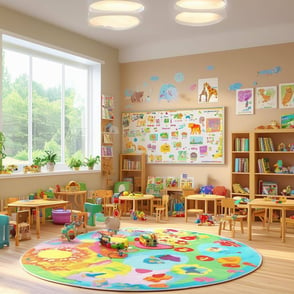Discover effective strategies to teach preschoolers reading and writing skills in English with this comprehensive step-by-step guide. We take literacy very seriously at Hatching Dragons - the ability to read and write is one of the principal pillars of communication and Language, a prime area of learning in the EYFS. We start in our baby room, with mark making classes that intend to nurture fine motor controls and skills in handling - working with crayons first and eventually pencils to help children see how marks can have meaning. Our Calligraphy classes are a really amazing tool to achieve this - pictographic character based languages like Chinese are, in themselves, mini works of art, helping children see meaning in the image and picture. And as they grow up through Blue Dragons and our toddler class, the alphabet is introduced through letters and sounds and eventually, Jolly Phonics, a programme to ensure our children are school ready and literate by five.
The Importance of Early Literacy
Early literacy is crucial for preschoolers as it lays the foundation for their future reading and writing skills. By introducing literacy activities early on, children develop a love for reading and writing, which can have a positive impact on their academic success. Research has shown that early literacy experiences are closely linked to cognitive development, language skills, and overall academic achievement.
To promote early literacy, it is important to create a literacy-rich environment that exposes children to a variety of books, print materials, and language experiences. This can include setting up a cozy reading corner with a collection of age-appropriate books, labeling objects in the classroom with words and pictures, and engaging in storytelling and rhyming activities. By creating an environment that encourages exploration and curiosity, preschoolers are more likely to develop a strong foundation in literacy.
Creating a Literacy-Rich Environment
A literacy-rich environment is essential for fostering preschoolers' reading and writing skills. Here are some strategies to create a literacy-rich environment:
1. Set up a dedicated reading area with a variety of books that cater to different interests and reading levels. Make sure to rotate the books regularly to keep the selection fresh and exciting.
2. Label objects and areas in the classroom with words and pictures. This helps children associate words with their corresponding objects and builds vocabulary.
3. Incorporate literacy into daily routines and activities. For example, during snack time, encourage children to read the labels on food packages or create a menu for a pretend restaurant.
4. Engage in storytelling and rhyming activities. Use puppets, props, and visual aids to make the stories come alive and encourage children to participate and retell the stories in their own words.
By creating a literacy-rich environment, preschoolers are surrounded by opportunities to engage with print and develop their reading and writing skills naturally.
Introducing Phonics and Letter Recognition
Phonics instruction is a fundamental component of teaching preschoolers to read and write. Phonics involves teaching children the relationship between letters and the sounds they represent. Here are some tips for introducing phonics and letter recognition:
1. Start by teaching the alphabet and the corresponding letter sounds. Use visuals, songs, and gestures to make it fun and memorable.
2. Once children are familiar with the letter sounds, introduce simple phonics activities. For example, play games where children identify the initial sound of words or sort objects based on their beginning sounds.
3. Gradually introduce more complex phonics concepts, such as blending sounds to form words and segmenting words into individual sounds.
4. Provide plenty of opportunities for children to practice their phonics skills through games, worksheets, and hands-on activities.
By introducing phonics and letter recognition in a systematic and engaging way, preschoolers can develop strong decoding skills and become confident readers and writers.
Developing Vocabulary and Comprehension Skills
Building vocabulary and comprehension skills is essential for preschoolers to understand what they read and express themselves effectively through writing. Here are some strategies to develop vocabulary and comprehension skills:
1. Read aloud to children regularly and discuss the stories. Ask open-ended questions to encourage critical thinking and comprehension.
2. Introduce new vocabulary words through read-alouds, conversations, and word games. Use context clues and visuals to help children understand the meanings of words.
3. Encourage children to use new vocabulary words in their everyday conversations and writing. Provide opportunities for them to practice using the words in meaningful contexts.
4. Engage in activities that promote comprehension, such as retelling stories, making predictions, and asking children to draw or act out their favorite parts of a story.
By actively developing vocabulary and comprehension skills, preschoolers can enhance their reading and writing abilities and become more proficient in English.
Engaging Preschoolers in Reading and Writing Activities
Engaging preschoolers in reading and writing activities is key to fostering their love for literacy. Here are some ideas to make reading and writing fun and interactive:
1. Provide a variety of reading materials, including picture books, storybooks, magazines, and informational texts. Let children choose what they want to read and encourage them to share their favorite stories with their peers.
2. Set up a writing center with different writing tools, such as crayons, markers, and colored pencils, as well as various types of paper. Encourage children to write their own stories, letters, and lists.
3. Incorporate technology into reading and writing activities. Use interactive apps, e-books, and educational websites to make learning engaging and interactive.
4. Organize book clubs or reading circles where children can discuss and share their thoughts about books they have read. This promotes social interaction and critical thinking skills.
By providing a wide range of reading and writing activities, preschoolers can develop a lifelong love for literacy and become confident readers and writers.

09-Feb-2024 12:27:49
Related Articles





Write a Comment